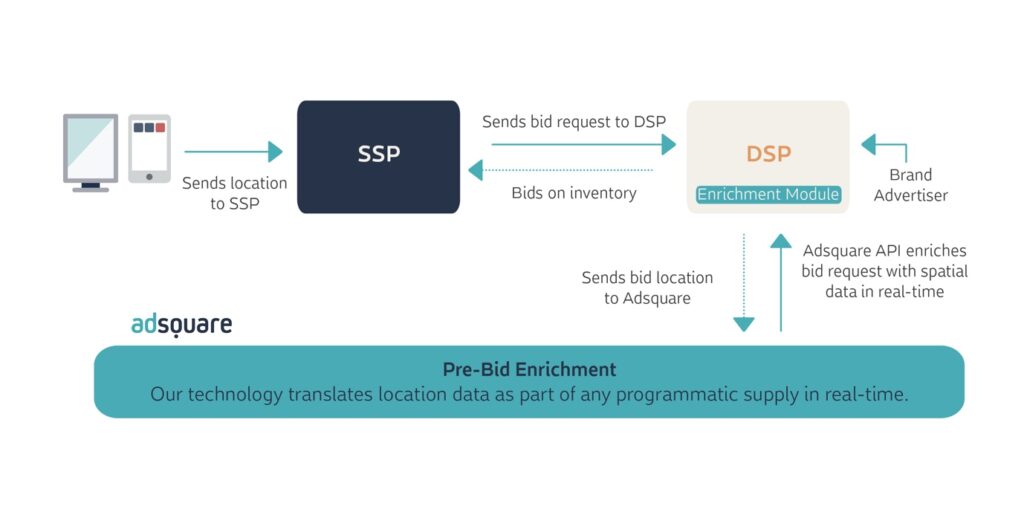
About Christoph Herwig
Christoph is VP Global Marketing at Adsquare and based in the Berlin HQ. Before leading the marketing activities, Chris was VP Data Partnerships and responsible for Adsquare's global data supply.
A lot has been written about the changing marketing landscape. Identity-based targeting may be on the decline. New privacy regulations like GDPR or CCPA, restrictions on advertising identifiers imposed by Google or Apple, and a new consumer awareness have accelerated this change over the past months. The authenticated traffic will be limited in scale and restricted to those users actively logging into websites and apps. Leveraging the anonymous web will become more important and in consequence, contextual targeting is experiencing a renaissance. One particular concept of contextual intelligence, which has long been underrated, currently stands out: Proximity Targeting.
In this article we address the technical requirements behind Proximity Targeting as well its growing importance in this new era of consumer privacy.
Proximity Targeting is what we call our geo-contextual targeting solution that works through pre-bid enrichment API integrations with programmatic platforms such as Demand Side Platforms (DSP). The pre-bid enrichment server is the component responsible for receiving and enriching ad requests – in our case based on location information (latitude, longitude) – in real-time.
In other words, Adsquare’s technology enriches mobile devices’ or digital Out-of-Home screens’ geo-locations sent in the bid request with spatial data in real-time. This allows advertisers to reach relevant audiences based on their location context in the moment of an ad impression. Proximity Targeting works without cookies or Identifiers for Advertising (IFA) and people are in no way being targeted – only locations. This makes Proximity Targeting fully privacy compliant by nature.
Proximity Targeting is the future of data-driven marketing as it allows advertisers to offset the deprecation of identifiers in the mobile space and open new opportunities to significantly improve the targeting of DOOH campaigns.
The programmatic media buying environment is highly fragmented, with numerous players involved in the process. There are DSPs, Publishers, DMPs, SSPs and more. Luckily, there is one connector among all of those players: data.
The data that is mostly available in the ecosystem describes static profiles. In large part it is processed via bulk uploads in a flat file format. This data is of high value, but how does it tie in with the demand for real-time data that considers both the holistic view on audiences and full compliance with privacy regulations?
With Adsquare’s pre-bid enrichment API integration into leading DSPs, you able to enrich the bidding process not only with rich audience data but also with dynamic spatial data, also known as geo-contextual data. This enables programmatic platforms to perform real-time decision making and bid adjustments. For instance, weather data can provide an hour by hour snapshot of what weather conditions will be like over the course of a day, allowing advertisers to choose frames and latitudes/ longitudes on a granular basis.
Where the latest iteration of Proximity Targeting really gets exciting is when geo-located audience data is added to the mix. Adsquare combines mobile audience data with SDK-derived background movement data and connects the corresponding audience segments to country specific geometries and OOH locations. Imagine, for example, a sports apparel brand being able to activate a marketing message on a digital billboard the moment a gym lover walks by, and then retargeting that same person on their mobile device moments later.
The pre-bid enrichment API connects Adsquare to the advertiser’s desired DSP seat. The integration enables us to enrich programmatic advertising traffic with pre-built spatial segments in real-time. In our platform, media buyers can effortlessly select single data sets (e.g., places of interest like shopping centres, restaurants or gyms) or combine multiple datasets in our platform including geo-located audience data or weather information (e.g., a catchment area of 50m around coffee places in neighbourhoods that index highly for luxury travellers and in sunny spells). The Proximity Targeting segments can then be activated by the advertisers in their DSP (seat ID) of choice for improved campaign performance.
What’s more, Adsquare provides a scalable server module which DSPs include to their infrastructure in order to minimise any latency. By doing so, we are able to enrich millions of bid requests every single second and that in less than 3 milliseconds. Smart data structures optimise memory footprint and delivery speed. The speed of performance means that the moment a DSP receives a bid request, it can check with Adsquare whether the latitude/longitude of the anonymous device, or the digital OOH screen for that matter, qualifies for the desired geo-contextual segment. If it does, then the programmatic buyer is invited to bid.

The enrichment module available by Adsquare is deeply integrated into the DSPs server infrastructure, so no network-latency is added on top. It contains not only highly optimised and self-developed in-memory databases, but also takes care of special pre-processes such as fraud-control and location qualifying. It is continuously and automatically updated by the Adsquare platform in the background via the so-called sync module.
In addition to this, it is important to reiterate that data owners supply their assets in many different formats. For real-time targeting, it is fundamental that different sets of data can be onboarded to enrich the bid stream effortlessly and quickly, and this is why within the pre-bid integration, we enable this effortlessly through the sync module within the enrichment API. The sync module ensures that the enrichment API within the DSP is always updated with the most relevant and optimised data for real-time enrichment. This is needed for data and solutions that rely on real-time information such as weather data or our consumer mobility datasets. (Learn more on Adsquare’s Audiences in Motion here).
The pre-bid integration is the main enabler for advertisers to target users based on their current geographical context. Proximity Targeting has become one of the most powerful marketing solutions in our privacy-first world. Understanding the context of the user in the right mobile moment is the first step to successful targeting. However, it is not the core competency of a DSP. Adsquare’s module is fully optimised and horizontally scalable, allowing us to process up to 1M queries per second (QPS) on an average server.
If you’re interested to learn more about Proximity Targeting in action and its underlying data, please download our whitepaper on Location Context 2.0.
Looking for a job in AdTech? Feel free to check out our vacancies.
About Christoph Herwig
Christoph is VP Global Marketing at Adsquare and based in the Berlin HQ. Before leading the marketing activities, Chris was VP Data Partnerships and responsible for Adsquare's global data supply.